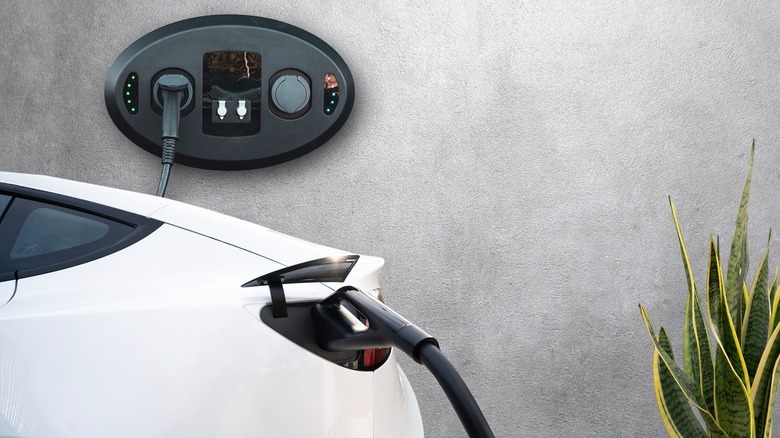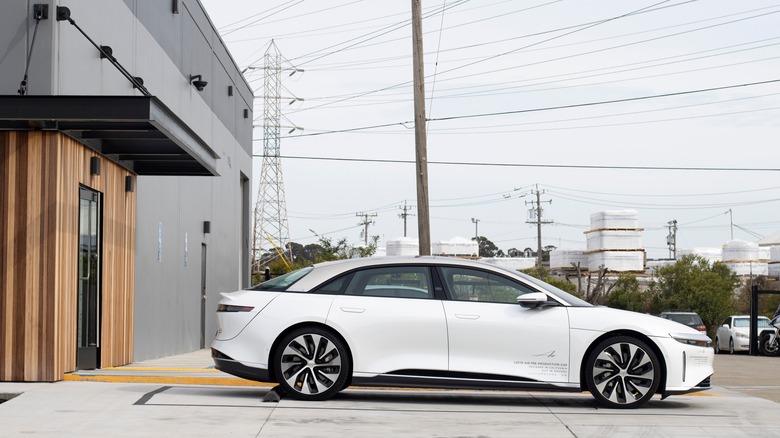Here's How Much Electric Car Range You Really Need
Electric vehicles are becoming more common in the United States with each passing year. Today, almost 2 million electric vehicles are operated on U.S. roadways, according to Pew Research Center. With new legislation slated to make electric vehicles the de facto priority for auto manufacturers competing in the U.S. market, this trend is only going to continue speeding up over the coming years. But a change to electric vehicle usage may have some consumers worried about their ability to continue making their daily commute without hindrance. Some consumers may be worried that electric vehicles provide a much less robust effective range than a traditional gas-powered car. In some instances, this is certainly true. Wallbox reports that the typical gasoline-powered vehicle sits somewhere in the middle of this scale of the effective range that EVs bring to the table — with certain Tesla and Hyundai models performing better.
But a raw figure of distance isn't the best way to judge whether an EV can benefit your household and daily commute. The truth is that the actual range you require from an electric vehicle should be calculated very differently from that of a gasoline-powered automobile.
Average driving distance varies, but adds up to roughly 40 miles per day
State by state comparison is required to work out how much you're likely to drive on a yearly or monthly basis. Policy Genius notes that drivers in Rhode Island log the fewest miles per year at 9,961 (for a state — D.C. drivers average just less than half that figure at 4,623 miles per year). Conversely, those in Wyoming travel an average distance of 24,069 miles each year.
Another way of looking at this is in monthly tallies. The U.S. Federal Highway Administration estimates an average of 1,189 miles are driven per month by the typical American driver. EV Box reports that the average electric vehicle has a range of 194 miles; with a low figure of 84 miles, and the longest range clocking in at 396 miles. Various cars of any propulsion type will produce stunningly different driving experiences, but car owners thinking of switching to an EV model will want to consider the same range calculations that they would when approaching a combustion engine vehicle's gas tank capacity.
Those who enjoy short commutes and rarely engage in longer road trips won't demand a high capacity EV, whereas those who spend an hour or more on the road each day will need to invest in an EV with more substantial range.
At any rate, with an average commute of 40 miles (per FHA estimates), even the lowest capacity EV would handle two days of driving without failure.
Charging availability — not total range — is the real factor
Rather than thinking of the total range that you need to extract from an EV, evolving your thinking to consider how often you'll need to charge, and what the availability of EV charging infrastructure is in your area, is necessary. Just as driving habits vary by state, availability of charging stations is also dispersed in its own pattern across the United States. My EV reports that publicly available charging options exist in abundance in the three states that have seen the highest levels of adoption of EV technology so far: California, Texas, and Florida, with New York trailing at fourth place in this metric.
In reality, the distance you'll require from your electric vehicle is a calculation involving both the typical range that you see driven on any given day, and the frequency with which you hope to charge your car. Many homeowners who have adopted EV transportation technology have also built charging infrastructure into their homes. Replenishing the battery at night has become as ingrained a process as starting the dishwasher or plugging in a phone before going to bed. With this type of routine, your actual range requirement is only a single day of movement.


